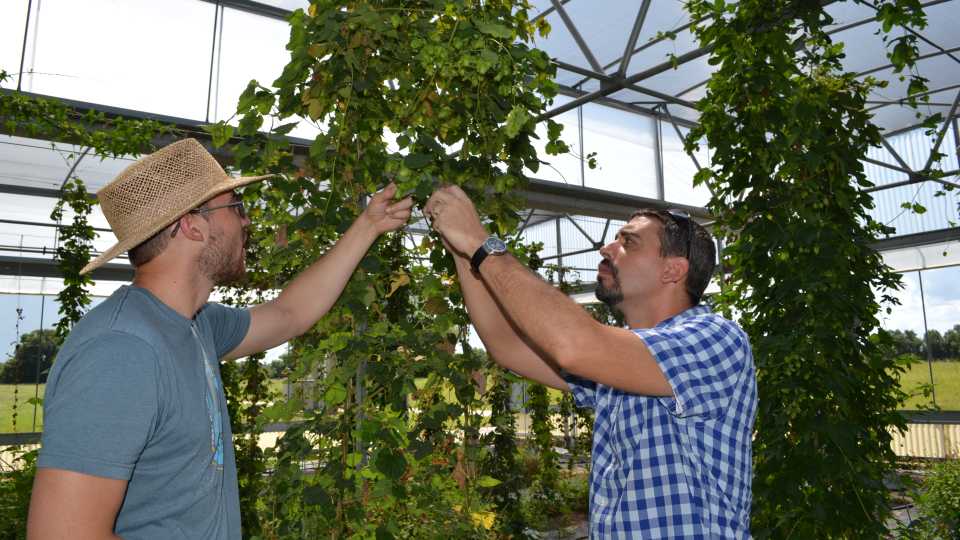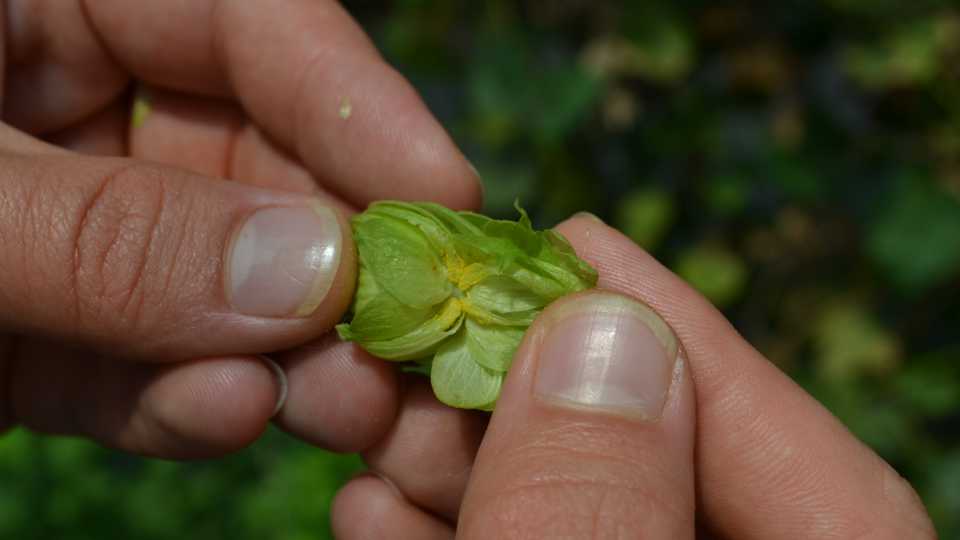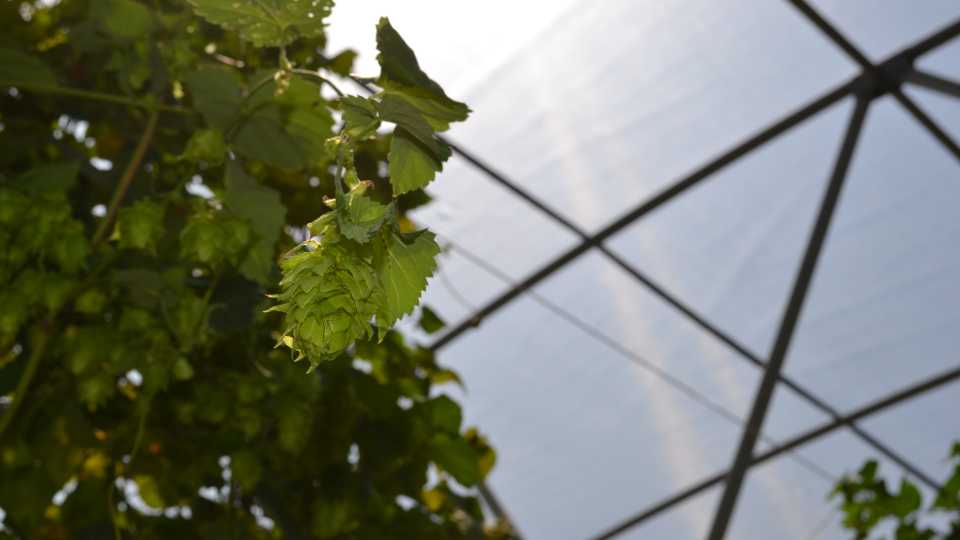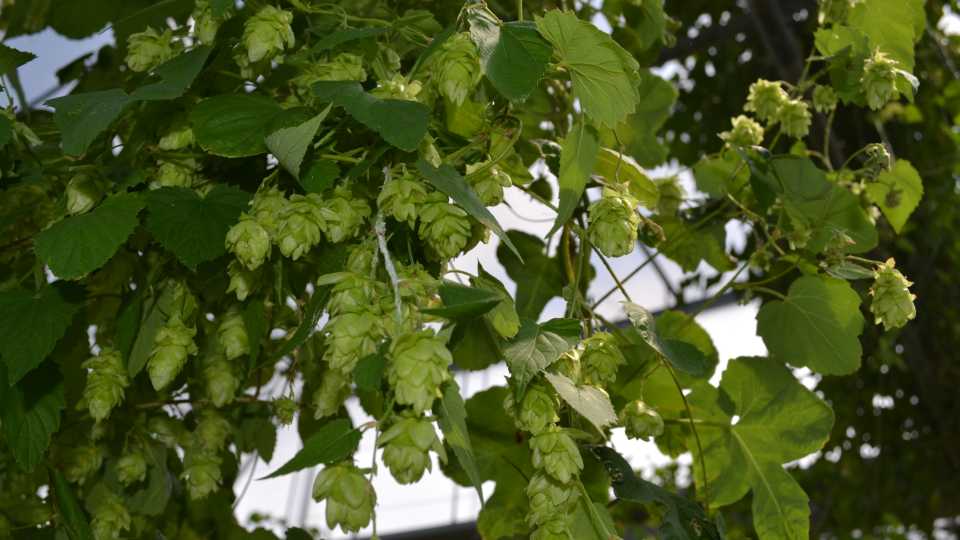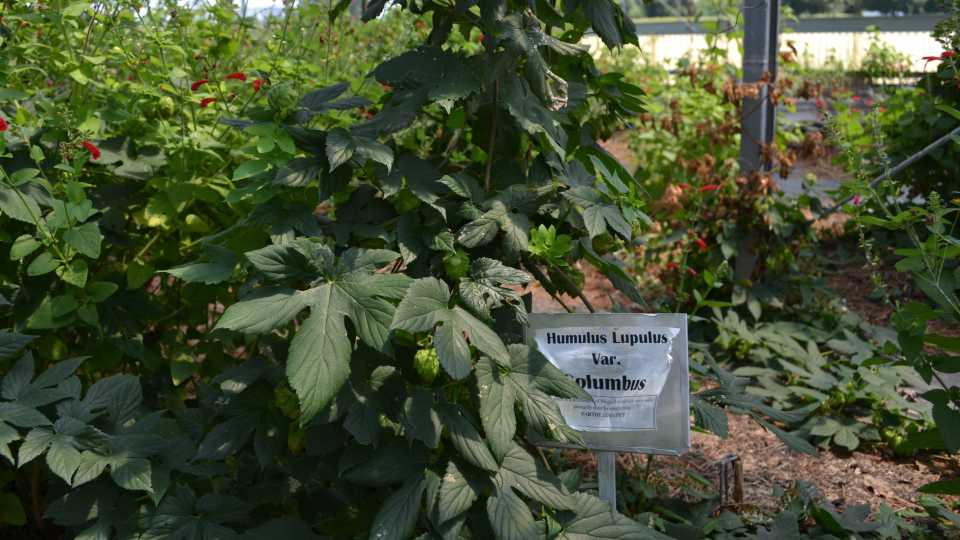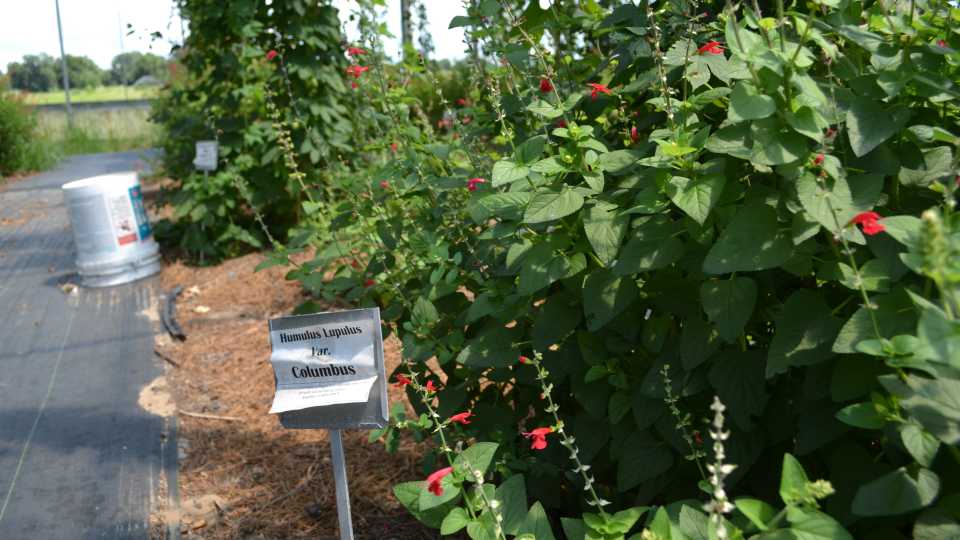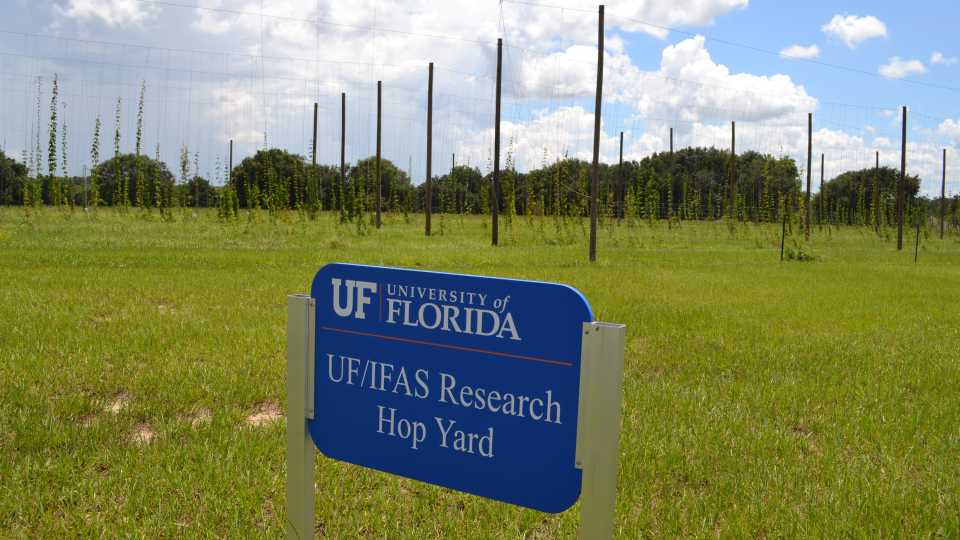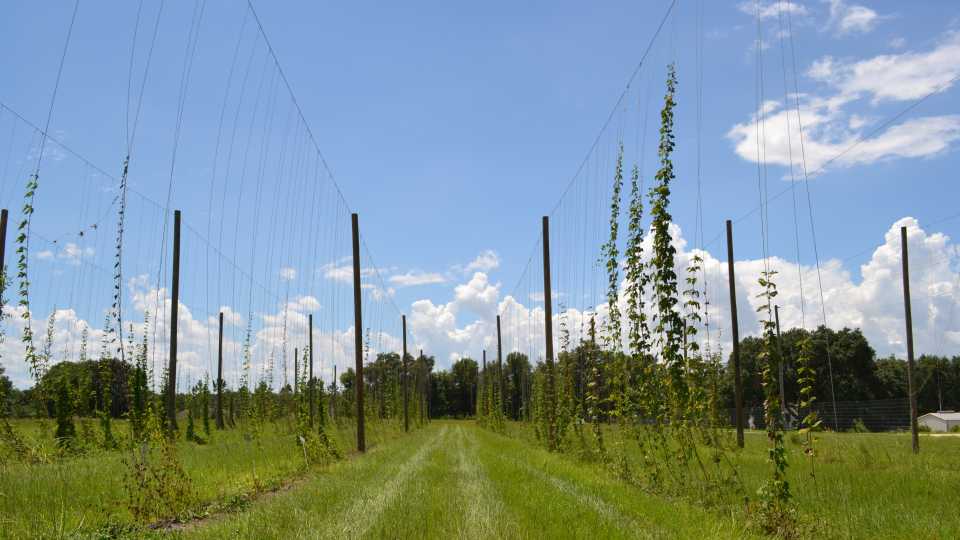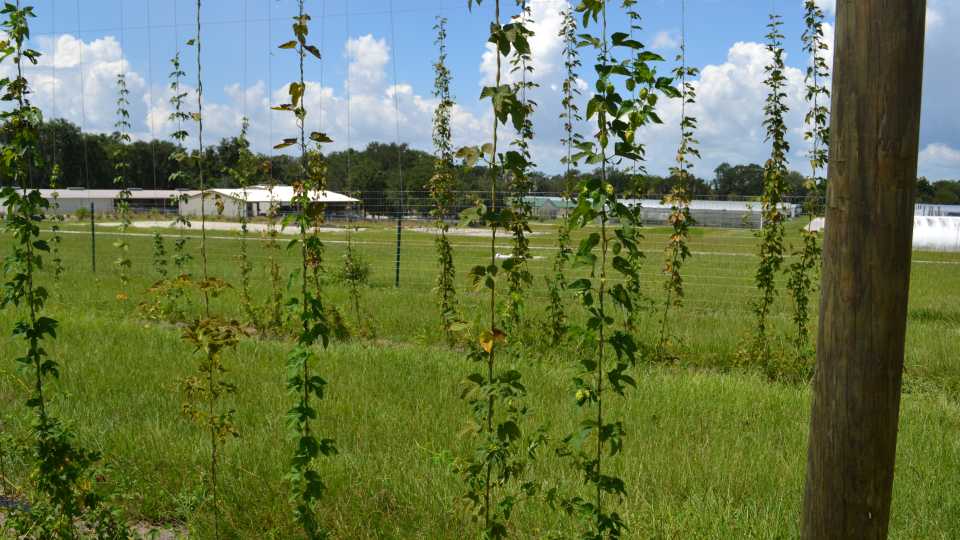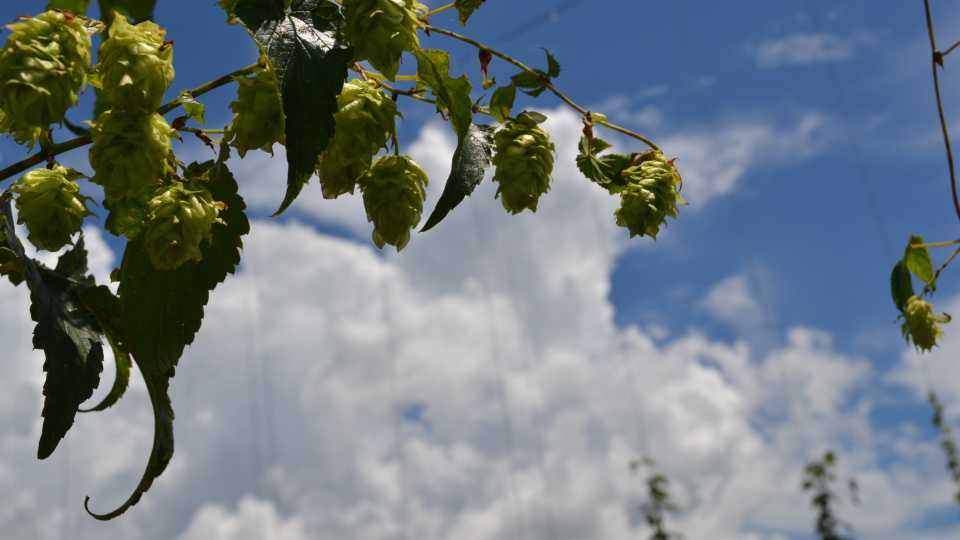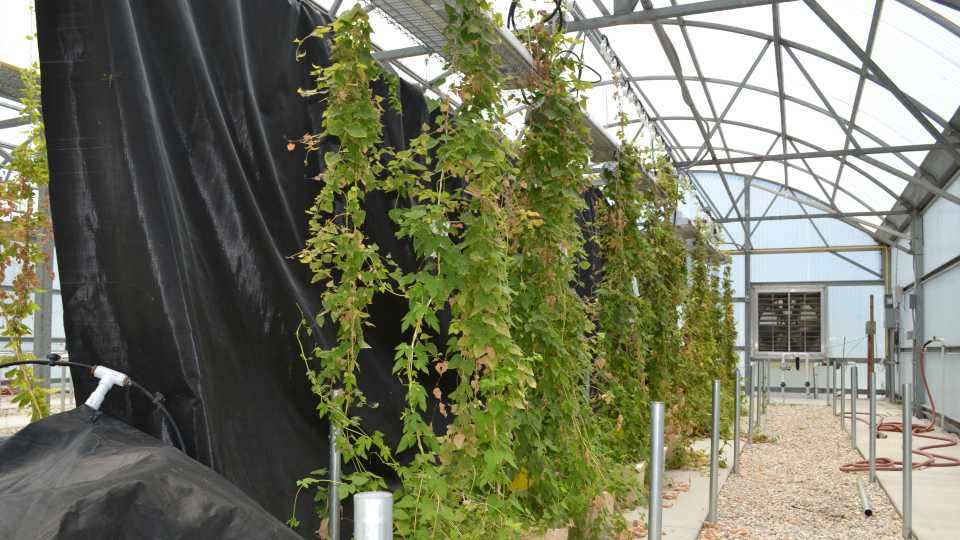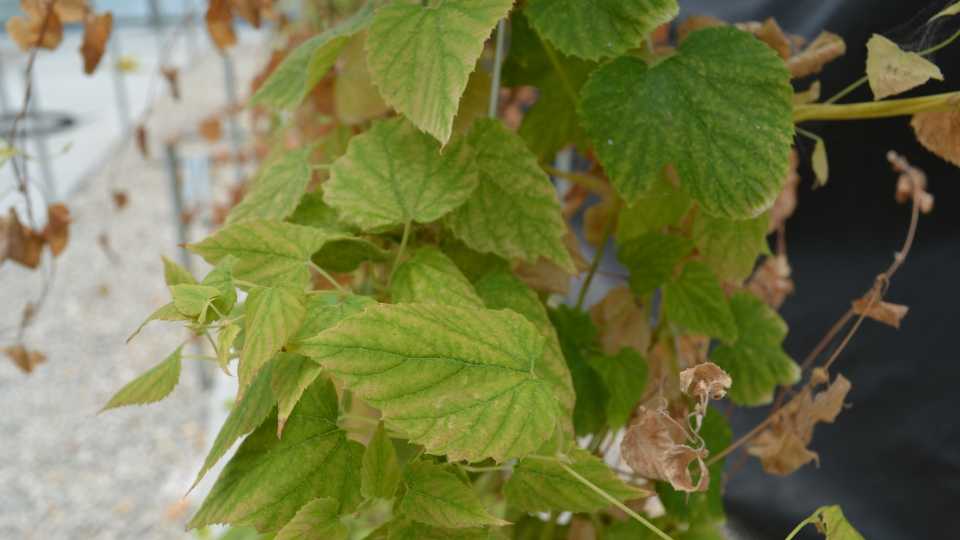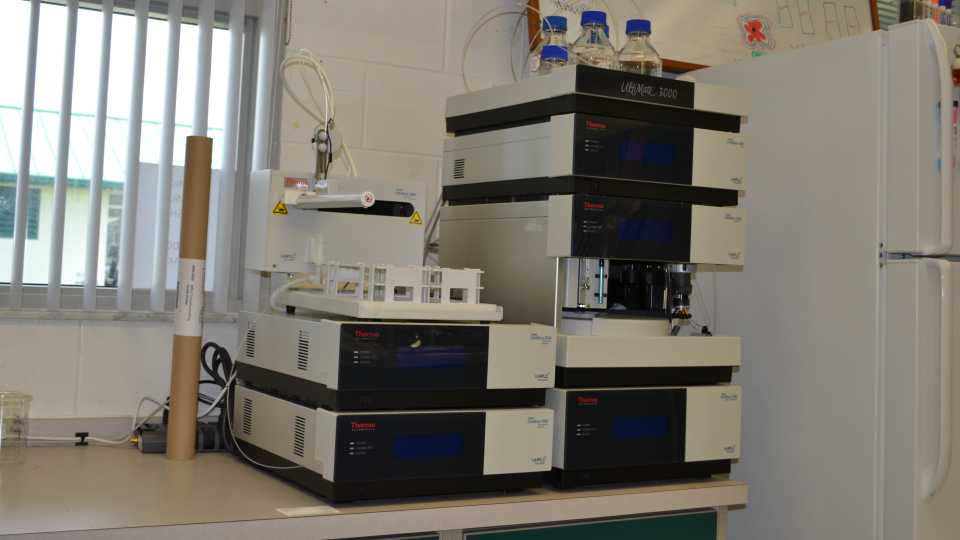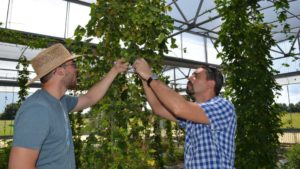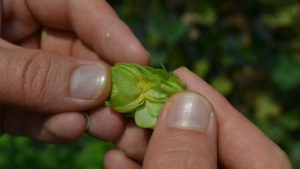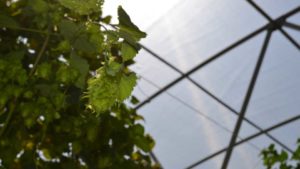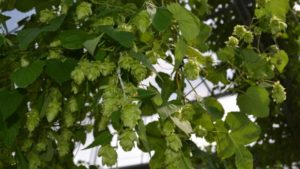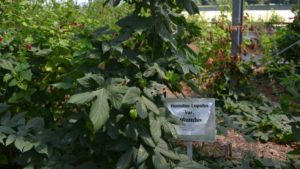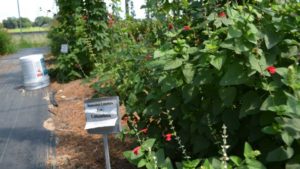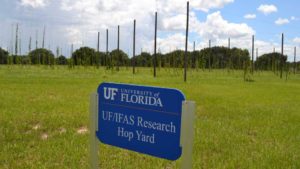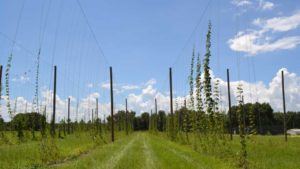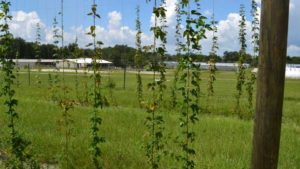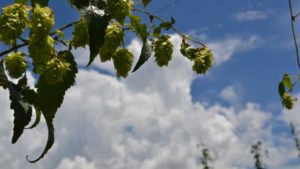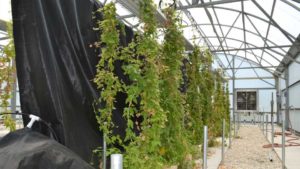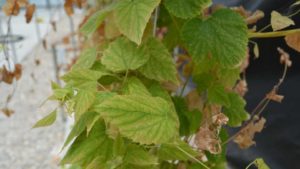Hopes High for Hops Fresh From Florida
[Editor’s Note: Interviews were conducted and the article was written before Hurricane Irma’s impact*]
Despite Florida farmers already producing roughly 300 different agricultural commodities, there’s always room for more, right? Out of the recent batch of promising alternative crop candidates, one keeps bubbling to the surface — hops.
The recent rise of the craft beer industry across the U.S. has been nothing short of meteoric. And the growth of the sector in Florida is no exception. According to the Brewers Association, there were 45 craft breweries in Florida in 2011. As of 2016, there were 195 and counting. Given the staggering expansion, along with a burgeoning locavore movement, there is ample opportunity for growers to sample something new says Simon Bollin, Agribusiness Development Manager for the Hillsborough County Economic Development Department. “With HLB in citrus and urban sprawl happening in many parts of the state, growers are looking to get more from their land,” he explains. “If it’s economically feasible, hops could be one of several value-added alternative crops.”
From Fantasy to Reality
The fact hops are even being vetted for commercial production in the Sunshine State is a bit of a minor miracle. But, it is happening. Brian Pearson, Assistant Professor of environmental horticulture at the UF/IFAS Mid-Florida Research and Education Center (MREC) in Apopka, has been dreaming of this scenario for some time and actively researching this possibility since 2011. Being a self-proclaimed “beer nerd” and home brewer, Pearson was determined to find if hops could actually grow in Florida. Little did he know then what would start as a self-indulgent experiment would turn into a full-blown Extension research project backed with government funds.
“The idea for the project came to me literally on a Sunday while I was home brewing in my back yard,” Pearson says. “I bought some rhizomes and planted them here at my work place to grow, measure, and evaluate. After about a year or two of doing that, I realized this actually has research potential.”
Pearson’s curiosity couldn’t have come at a better time. Interest from farmers and other parties followed. In 2015, UF/IFAS researchers Zhanao Deng and Shinsuke Agehara at the Gulf Coast Research and Education Center (GCREC) in Balm got wind of what was going on in Apopka. A hop yard soon was installed at the GCREC (BTW: You can check out GCREC’s hop yard during the 2017 Florida Ag Expo).
With research wheels fully turning, UF/IFAS was awarded a $158,000, two-year grant from the Florida Department of Agriculture and Consumers Services to explore hops as an alternative crop. Pearson, Agehara, and Deng have been collaborating and finding hop production in Florida is not for the part-time grower.
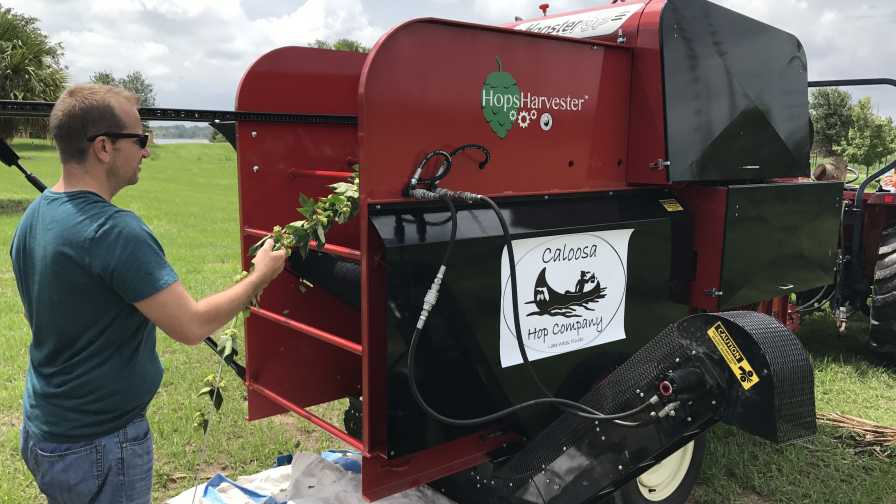
Hand harvesting is very time-consuming when it comes to hops. A mechanical harvester helps streamline the process of separating hop cones from bines.
Photo courtesy of Caloosa Hop Co.
Among the top challenges, Agehara and Pearson point out four major considerations.
1. Lack of Data: Despite having been used in beer in Germany since the 800s, Pearson says there are very few scientific papers that have ever examined environmental factors on hop production for this part of the world.
“There are 365 different cultivars I have cataloged, 40 which are popular for brewing,” he says. “After doing several years of work, we’ve whittled that down.”
2. Climate: In the Pacific Northwest (PNW), day length is longer during the early growing season, inhibiting flowering at the immature stage and maximizing vegetative bine growth. “When day length becomes shorter than 15 hours, all bines initiate flowering, allowing high cone yields and synchronized production (single harvest),” Agehara says.
In Florida, maximum day length is only about 14 hours, which could initiate premature flowering, thus limiting vegetative growth and cone production.
“Hop cones need to be harvested multiple times, which requires significant amounts of labor,” Agehara adds.
To overcome this obstacle, Agehara offers a two-step approach.
“First, it is important to use a variety that is less sensitive to photoperiod and capable of producing high yields. Second, the use of LED lights to artificially change the photoperiod may overcome the environmental limitation. This option will be tested in a newly approved project in 2018-2019.”
3. Pests: Florida is famous/infamous for its prolific pest pressure. Hops are not immune.
“We have observed various kinds of pests in our field trials, including plant viruses, spider mites, thrips, nematodes, etc. But the information for potential impact and management options is severely lacking,” Agehara says.
To avoid viral infection during establishment, Agehara recommends using tissue culture (TC) plants instead of rhizomes. Pearson concurs and says starting with clean plants is key. He sources Agri-Starts in Apopka for TC material and information.
“Tissue culture techniques allow us to guarantee there are no pathogens in the plant,” he says.
In addition to clean plants, fumigation during the hop yard preparation may be beneficial to eliminate/reduce some soilborne diseases and nematodes. Options to control other pests and diseases are to be evaluated in future studies.
Pearson adds, “With hops, especially in this region, spider mites can be a challenge. Aphids are a bit of a problem, but we’ve been able to reduce the population with banker plant systems and predatory insects.”
4. Harvesting Hurdles: The growing nature of hops makes harvesting a tall order. Large growers in the PNW use mechanical harvesters to separate bines and cones. Pearson says, without having a mechanical harvester, there’s a lot of hand labor.
“When you’re hand harvesting, depending on how many cones are present, you can spend an hour per plant. If you have a quarter acre, you can easily fit 200 to 300 plants,” he says. “If you don’t have equipment, then the question becomes: How many people work on your farm? Because, you’re going to need a lot of them.”
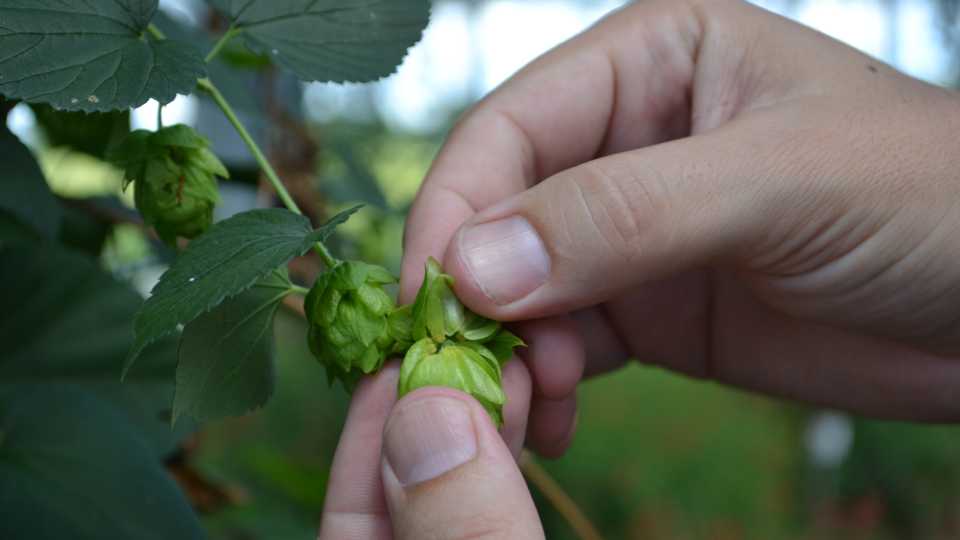
Photo by Paul Rusnak
Top Hops
Regarding what hop cultivars Florida growers should consider, Pearson recommends the following: ‘Cascade,’ ‘Chinook,’ ‘Columbus,’ ‘Comet,’ ‘Zeus,’ and some of the Neomexicanus.
“‘Neo1’ is our top performer here,” he says. “It’s not all that surprising since the plant is native to a hot environment [Desert Southwest] vs. those bred for Germany or Washington State.”
According to Pearson, hops, much like grapes, pick up a flavor profile unique to the region in which they are grown.
“I tell brewers, our hops may taste and smell different,” he says. “So far, we’re seeing that a hop grown here smells and tastes like Florida, at least in the data when looking at the oils. Certainly, we’re seeing different volatile profiles, and our brewers are beyond bonkers about that.”

Ricky Burts of Burts Farms is passionate about making a name for fresh Florida hops.
Photo by Paul Rusnak
Growth Potential
While there is more sophisticated research going on in other crop areas, general interest in hops is tops among visitors to the MREC, Pearson points out.
“Hops has a sex appeal where I don’t have to explain why we’re doing it. Being able to go into a brewery and have something local, that resonates with a lot of people.”
It’s certainly reverberating with growers and/or wannabe growers, too.
“In 2015, there were no reported commercial hop growers in Florida,” Agehara notes. “In 2016, we hosted four field days, and more than 100 local growers (mainly citrus and vegetable) and 20 brewers visited the hop yard in Balm.”
As of this posting, the exact number of hop growers in Florida was unknown. Pearson guesses between 10 to 15. Agehara cited, of those, maybe five had somewhere approaching 5 acres planted.
“There are many smaller (less than ½ acre) hop growers all looking to expand acreage as local production knowledge is researched and developed,” he says.
Among the more relatively established growers is Burts Farms in Dunnellon. Not all that long ago, Owner Ricky Burts was wrenching on motorcycles with Harley Davidson. Having been a mechanic for 15 years, Burts says he was moved to leave the hogs behind for farming thanks to a UF/IFAS AGRItunity event he attended a few years ago. While there, he heard Pearson speak about the potential of growing hops in Florida. Burts was sold.
“As soon as he got off the stage, I was on his heels asking more questions,” he admits.
Just a few days later, Burts placed an order for 144 plants, cleared out a section on his property, and built a trellis. “It was literally spur of the moment, let’s give it a try,” he muses.
Without a background in farming, he’s had to pour much time and effort to get a handle on his ambitious endeavor. “When you’re dealing with a crop 20 feet in the air, you have to get creative,” he says.
Yes, lack of day length is a challenge for Florida hop growers, but Burts sees it as an opportunity.
“We’ve been able to overcome that with feeding the plants the correct nutrients and having the soil base needed. At the end of the day, we get a steady flow of product to the market instead of one shot. That changes the game for the brewers. Not only do they get fresh hops once a year, they can get fresh hops three times a year.”

Educating the public about the potential of locally grown hops is something that energizes Ricky Burts. During this past summer, he traveled to several different microbreweries across the state with his harvester and trays of hop plants in tow to give interested patrons an up-close look at the driving force behind their favorite beverage.
Photo by Paul Rusnak
Burts cautions those considering hops to start small.
“If we as growers come out too heavy handed and start giving poor quality, it’s going to give a bad name for Florida hops.”
The attention to quality has helped Burts establish relationships with multiple local breweries, including Marker 48 Brewing, Twin Bays Brewing, Southern Brewing, Flying Boat Brewing Co., among others.
“The demand is so high, when I grab the phone, that brewer is going to take them.”
As the learning curve is steep for all involved, Burts decided to form the Sunshine Hop Growers Alliance to not only give producers a voice, but also to share information, resources, and even equipment.
“I developed it for growers to come together and help each other out,” Burts explains. “For example, I just bought a hop harvester. If another grower in Florida needs it, it’s here for their access.”
The organization started with just a handful of members. Burts says, like the industry, it will grow. “Right now, there are just not many growers out there.”
*Post-Irma update: According to Burts, roughly 85% of his crop and nursery plants were lost due to the storm. “We are saddened to see all of the hard work, blood, sweat, tears, and thought be set back,” Burts posted on his Facebook wall. “I did say ‘set back.’ We are not done. We will rebuild even stronger.”
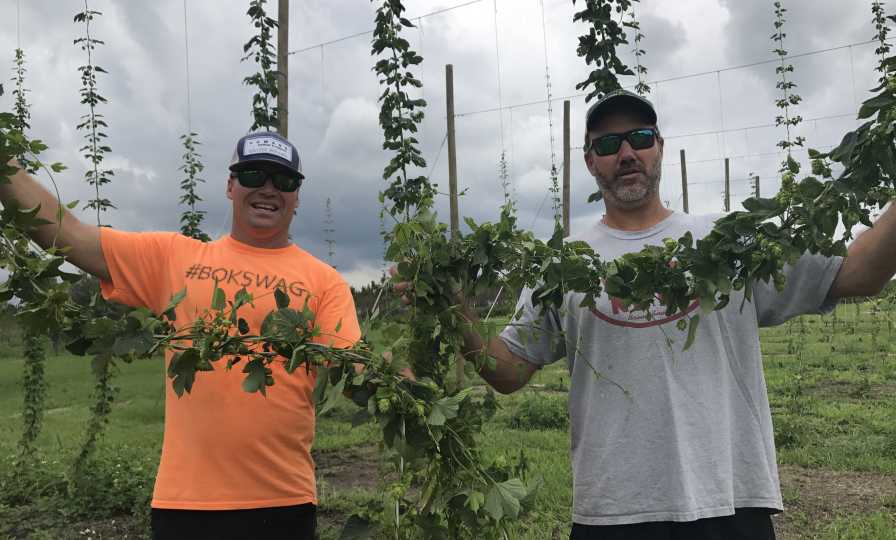
The crew from Caloosa Hop Co. in Lake Wales is learning a lot in its new endeavor.
Photo courtesy of Caloosa Hop Co.
Another growing operation finding its footing in Florida’s fledgling hop market is Caloosa Hop Co. in Lake Wales. At the time of this interview, the company was consulting, marketing, and harvesting (farm to fermenter) 4 total acres between it and growers seeking its service. Managing Partner Kevin Updike has been in and around the Florida citrus industry his whole life and sells product for Howard Fertilizer. While he’s still quite bullish on citrus, hops are squarely on the radar for Updike and his partners Brian Marston and Tom Kirschner, both also sporting deep-seated citrus backgrounds. Though the trio has land to expand, Updike says a thorough look at the balance sheet will determine growth plans.
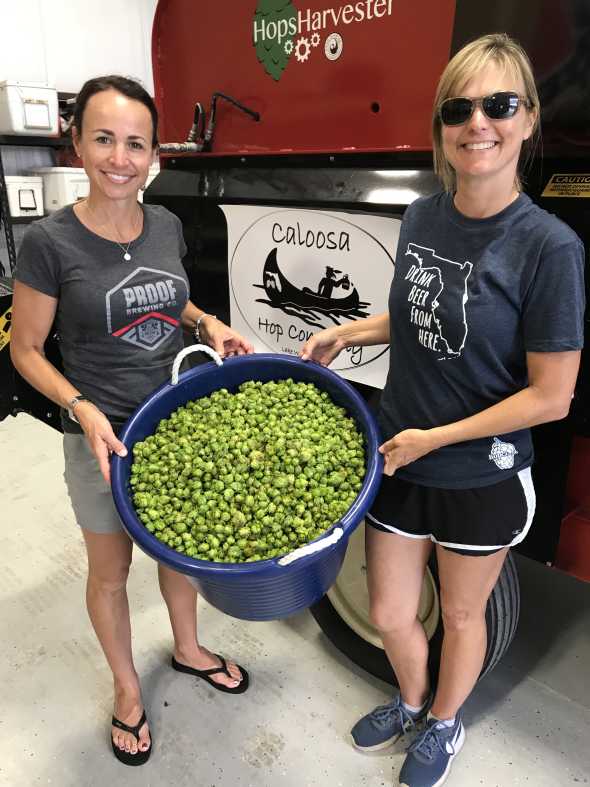
Happy harvest time at Caloosa Hop Co.
Photo courtesy of Caloosa Hop Co.
“I don’t want paint citrus growers a pretty picture,” he says. “It’s something that won’t be for everybody.”
As with any new undertaking, Updike says there is a lot more learning than earning right now.
“The training, trimming, and weed control are very labor intensive,” he says. “The kind of fertilizers they want and when are things we’re still trying to figure out.”
Aside from the production end of it, Updike stresses the importance of marketing. In a relatively short time, Caloosa Hop Co. has connected with several local breweries, including Crooked Thumb Brewery, JDub’s Brewing, Swamp Head Brewery, Swan Brewing, and Wop’s Hops. It’s not by accident. Updike says successful growers will visit brewers, attend beer festivals, and become involved in industry associations like the Florida Brewers Guild.
“The guys making money are the ones selling,” Updike remarks. “It’s my dream to have a hops packinghouse and market Florida hops. But we have to create the market, and that’s why we are growing them.”
For now, Updike is minding marketing, fine-tuning production, and focusing on finding varieties that will work best for the breweries he’s trying to serve.
Currently, Caloosa is successfully growing ‘Cascade,’ ‘Chinook,’ ‘Nugget,’ and ‘Tahoma.’ Updike says he also has about 20 other varieties on trial.
“I’m fairly confident you can grow ‘Cascade’ commercially in Florida. But brewers aren’t going to continue to just put a hum-drum ‘Cascade’ in their beer. They are going to want bittering and some other aroma hops to work with it.”
*Post-Irma Update: Structurally, Caloosa Hop Co. weathered the storm OK, Updike reported. “We harvested the crop the Friday before Irma came. The plants left took a beating, but we’re all very fortunate.”

Vats line the walls of 3 Daughters Brewing in St. Pete. The kind of hops that go into each batch of craft beer is essential in creating a successful recipe.
Photo by Paul Rusnak
View From the Brewery
Growers like Updike and Burts are spot on in recognizing brewers are seeking something not only different, but uniquely local. 3 Daughters Brewing has been on the front lines of the local hops movement ever since it served up a small batch of its Beach Blonde Ale with the first set of hops raised at the GCREC last fall. The truly local brew was a hit, and is a hint of things to come, says Mike Harting, CEO of 3 Daughters.
“It’s natural to root for the home team,” he says. “We would have a natural proclivity to lean toward anything grown local.”
Beyond the benefit of buy-local interests, Harting says it really comes down to dollars and cents. 3 Daughters currently sources its hops domestically from Washington State and Michigan, and even reaches as far as Germany and New Zealand for product.
“In the end, we pay an exorbitant amount in transportation costs to get hops from Germany,” Harting says. “There are an awful lot of financial elements that would lead us to want to do business here.”
There are other reasons breweries desire to have local hops at their disposal, says Ty Weaver, Head Brewer for 3 Daughters. He adds having local hops would offer the ultimate in fresh product, so brewing methods like wet hopping can be part of the mix. With current inventory lacking to make that happen regularly, the company makes the best of the system it has in place.
“We use all pelletized hops because it takes up a lot less space,” Weaver explains.
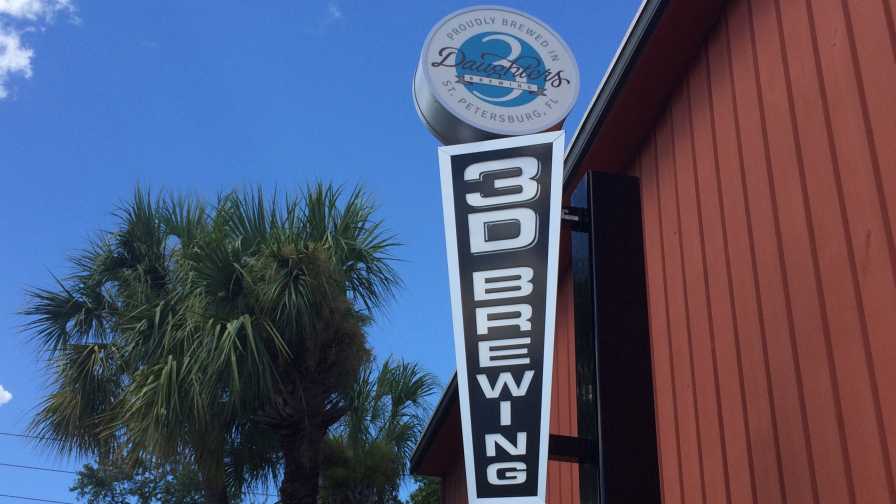
3 Daughters Brewing in St. Pete has served up craft beer made exclusively with Florida-grown hops before, and would be open to it again as growers gain footing.
Photo by Paul Rusnak
Given some of the logistical issues Florida breweries deal with, Ben Guzman, Event Coordinator with Gainesville-based First Magnitude Brewing Co., says the time is ripe to be a Florida hop grower.
“Because consumers are interested in locally produced beer, brewers are waiting in line to get their hands on any Florida-produced hops,” he says. “Demand is high, supply is low. It’s as simple as that.”
The Econ 101 comparison came to fruition for First Magnitude when it introduced a special batch dubbed Apopka Hop Pale Ale in April, aptly named since it was made from hops grown at UF/IFAS’ MREC.
“It was only available for that day, and we still receive phone calls on a weekly basis asking if we have any left,” Guzman gushes.
Similarly, just down the road from First Magnitude, is Swamp Head Brewery. Recently, the operation that prides itself on being “Inherently Floridian” teamed with Caloosa Hop Co. to release a unique batch of its Micanopy Moonbeam India Pale Ale. It was the microbrewer’s first made exclusively with Florida hops, but likely won’t be its last, says Brandon Nappy, Swamp Head’s Marketing Director. Like many, Nappy is pumped about the prospect of local hops, but also is cautiously optimistic as continuity remains a question mark.
“We’re ordering thousands of pounds of pelletized hops at a time, and we know for an entire year that exact hop will be available for each batch of beer we need it for,” he says. “That quality and consistency are elements we would be extremely excited if we can get there with Florida-grown hops.”
Weaver agrees with Nappy. “With the ground here being different, I don’t know if ‘Cascade’ grown in Florida is going to be the same as ‘Cascade’ grown in Washington. Until all of that is established, we’re looking for something new, something to make flavors with,” he says. “As growers get better at it, and we can get the same hops over and over, then we can make a full-time beer with that.”
Putting local supply desires aside, Harting states there is a need for more hops in the system overall.
“We have paid as much as $12 per pound for varietals over the last two years. That’s higher than red meat prices,” he exclaims. “There’s room on this planet for more hop acreage. The question is: Who wants to jump on it? Somebody, somewhere as individual farmers, or as a group, or as a subsidized government entity, is going to see this for what it is and pick up that mantle.”

Within minutes of First Magnitude Brewing Co. releasing a specialty batch of beer made exclusively with Florida hops, there wasn’t a drop to be had.
Photo courtesy of First Magnitude Brewing Co.
For the Love of Labels
Without question, the Fresh From Florida label carries weight with consumers. It only makes sense labels touting a truly local product would be desired by all interested parties. Updike says his company is navigating the Fresh From Florida moniker and what it means to local brewers. So far, he sees value in Fresh From Florida. “We need a label for beer.”
Pearson agrees and says promotion and branding of Florida-hopped beer will take the budding enterprise to the next level.
“We released First Magnitude’s Apopka Hop Pale Ale with the ‘Brewed With 100% Fresh From Florida Hops’ label to assist growers and brewers going through this process and let consumers know this is something unique,” he says. “In 20 minutes, all 30 gallons were gone.”
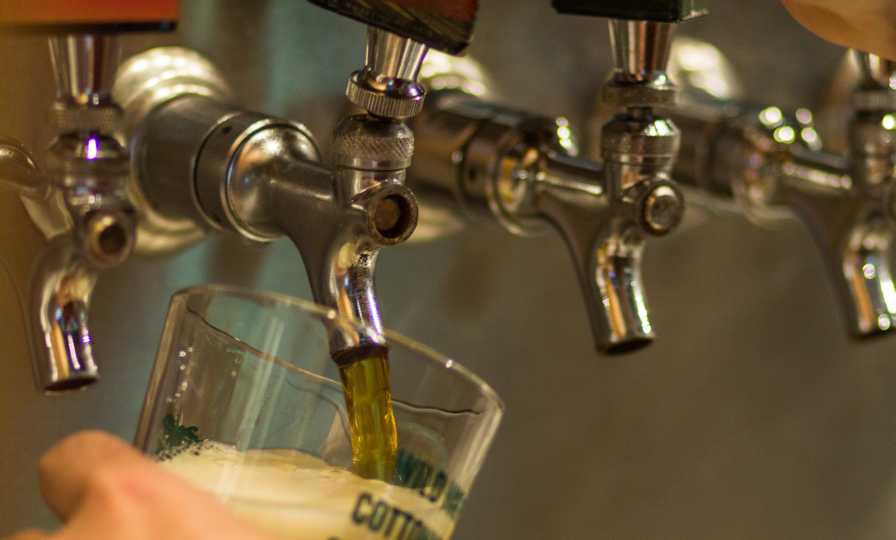
Photo courtesy of Swamp Head Brewery
What’ll You Have?
Besides a desperate need for local hops, there are some other commodities brewers are seeking. Perhaps you can help here. According to Guzman, local fruit is something they are always looking for, but price point can often be a deterrent.
Fruited beers are extremely popular, especially in Florida. Guzman says First Magnitude has made beer with papaya, cucumber, strawberries, blueberries, tangerines, blood oranges, grapefruit, cherries, grapes, ginger, lemon, honey, guava, etc. “We even make a brown ale we call Big Shoals with locally produced chestnuts. If you’re a farmer looking for some cool exposure, contact a local brewery and see if they have a use for your products. You’d be surprised by what brewers are using nowadays.”
Nappy concurs with Guzman about the creativity craft brewers are putting into their recipes. “Local brewers always have their ear to the ground for unique ingredients, especially if they can get them locally.”
Terms of En-Beer-ment
Want to grow hops for local brewers and beyond? Here are a few common terms you should know via CraftBeer.com’s Beer Glossary.
Alpha Acid: One of two primary naturally occurring soft resins in hops (the other is Beta Acid). Alpha acids are converted during boiling to iso-alpha acids, which cause the majority of bitterness. Beta acids contribute little to bitterness and account for some preservative quality.
[Weaver from 3 Daughters Brewing says growers should be familiar with the volatiles in their hop varieties. “I need to know what type of bitterness I’m going to get out of it before I create a recipe.”]
India Pale Ale (IPA): Characterized by floral, fruity, citrus-like, piney or resinous American-variety hop character, the IPA beer style is all about hop flavor, aroma and bitterness.
International Bitterness Units (IBU): The measure of the bittering substances in beer (analytically assessed as milligrams of isomerized alpha acid per liter of beer, in parts per million). This measurement depends on the style of beer. Light lagers typically have an IBU rating between 5 to 10; while bitter India pale ales often can have an IBU rating between 50 and 70.
Pellet Hops: Produced by grinding up the whole hop cones and pressing them into pellets.
Wet Hopping: The addition of freshly harvested hops that have not yet been dried to different stages of the brewing process. Wet hopping adds unique flavors and aromas to beer that are not normally found when using hops that have been dried and processed.




